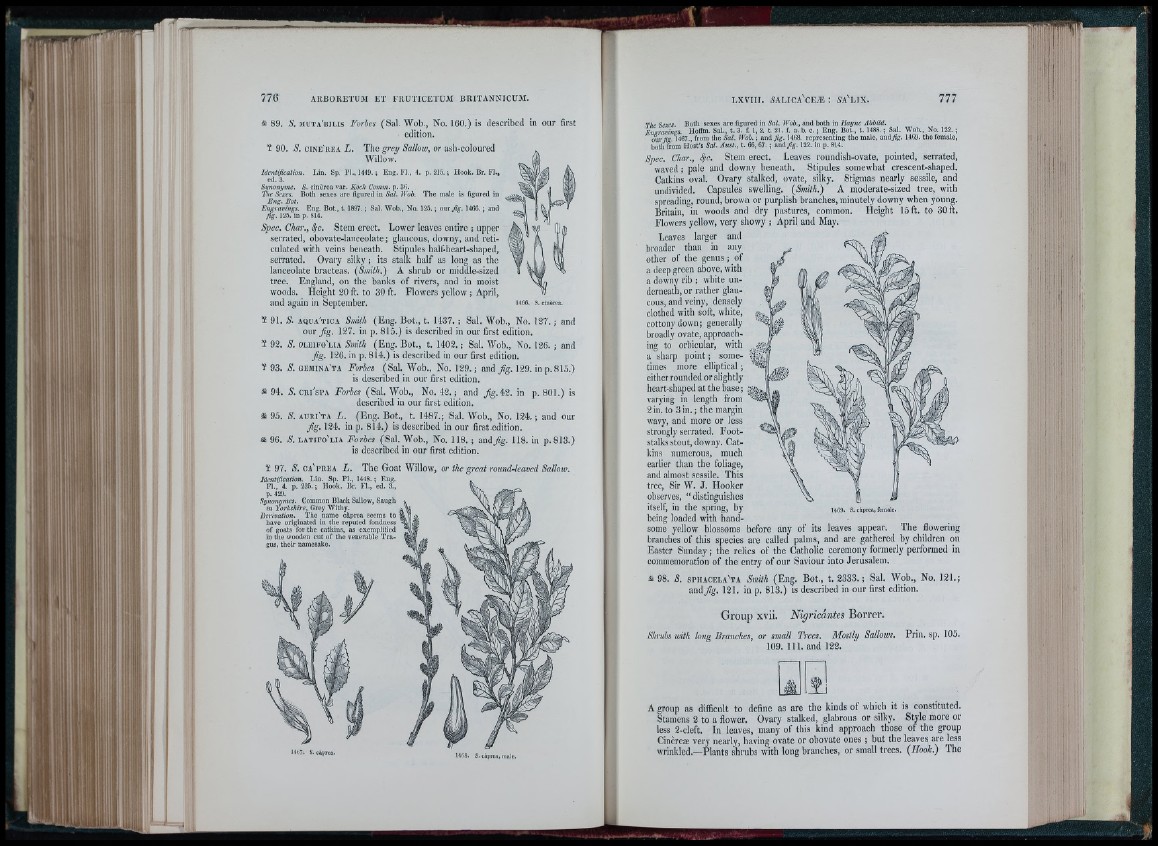
: ’ T T
lì
7 7 6
^ 89. S, m u t a ' b i l i s Forbes (Sal. Wob., No. 160.) is described in our first
edition.
¥ 90. S. c i n e ' r e a I j . The grey Sallow, or ash-coloured
Willow.
Identification. Lin. Sp. Pl., 1449. ; Eng. Fl., 4. p. 215. ; Hook. Br. FL,
ed. 3.
Synonyme. S. cinCrea var. Koch Comm. p. 3fi.
The Sexes. Both sexes arc figured in Sal. Wob.
Eng. Bot.
Et vittgs. Eng. Bot., 1 .1897. ; SaL Wob., No. 125. ;
g. 125. in p. 814.
The male is figured in
flg. 14GC.; and
Spec. Char., Stem erect. Lower leaves entire ; upper
serrated, obovate-lanceolate ; glaucous, downy, and reticulated
with veins beneath. Stipules haliWieart-shaped,
serrated. Ovary silky ; its stalk half as long as the
lanceolate bracteas. (Smilh.) A shrub or middle-.sized
tree. England, on the banks of rivers, and in moist
wootls. Height 20 ft. to 30 ft. Flowers yellow ; April,
and again in September. »‘lee. s. cinèrea.
¥ 91. S. a q u a ' t i c a Smith (Eng. Bot., t. 1437. ; Sal. Wob., No. 127. ; and
our j%. 127. in p. 815.) is described in our first edition.
¥ 92. S. O L E iF o 'iA A Smith (Eng. Bot., t. 1402.; Sal. Wob., No. 126. ; a n d
jdg. 126. in p. 814.) i s d e s c r i b e d i n o u r f i r s t e d i t i o n .
¥ 93. S. g e m i n a ' t a Forbcs (Sal. Wob., No. 129. ; and jUg. 129. in p.815.)
is described in our first edition.
3É 94. CRi'sPA Forbes (Sal.Wob., No. 42. ; and fig.42. in p. 801.) is
described in our fir.st edition.
Sfe 95. S. a u r i ' t a II. (Eng. Bot., t. 1487.; Sal. Wob., No. 124. ; and our
flg. 124. in p. 814.) is described in our first edition.
Sfe 96. S, l a t i f o ' l i a Forbes (Sal. Wob., No. 118. ; and fig. 118. in p . 813.)
is described in our first edition.
¥ 97. S. c a ' p r e a L . The Goat Willow, or the great round-leaved Sallow.
Identification. Lin. Sp. Pl., 1448. ; Eng.
FL, 4. p. 225.; Hook. Br. FL, ed. 3.,
p. 429.
Synonymes. Common Black Sallow, Saugh
in Yorkshire, Grey Withy.
Derivation. The name càprea seems to
have originated in the reputed Ibndness
of goats for the catkins, as exemplified
in the wooden cut of the venerable T ra gus,
their namesake.
M67. S. càprca. 1468. S. càpren.innlc,
The Sexes Both sexes are figured in Snl. Wob., and both in Hayne Abbild.
Enaravings. HoiJhi, SaL, t. 3. f. 1, 2. t. 21. f. a. b. c . ; Eng. Bot., t. 1488. ; SaL Wob., No. 122.;
our fig 1467., from the Sal. Wob. ; a n d /g . 1468. representing the male, a iid j^ . 14G9. the female,
both from Host’s Sal. Aust., t. 66, 67. ; a n d /g . 122. in p. 814.
Spec. Cha)'., 4'^* Stem erect. Leaves roundish-ovate, pointed, serrated,
waved ; pale and downy beneath. Stipules somewhat crescent-shaped.
Catkins oval. Ovary stalked, ovate, silky. Stigmas nearly sessile, and
undivided. Capsules swelling. (Smith.) A moderate-sized tree, with
spreading, rouncl, brown or [inrplish branches, minutely downy when young.
Britain, in woods and dry pastures, common. lleight 15 ft. to 30 ft.
Flowers yellow, very showy ; April and May.
Leaves larger and
broader than in any
other of the genus ; of
a deep green above, with
a downy rib ; white underneath,
or rather glaucous,
and veiny, densely
clothed with soft, white,
cottony down; generally
broadly ovate, apjiroach-
ing to orbicular, with
a sharp point; sometimes
more elliptical;
either rounded or slightly
lieart-shaped at the base;
varying in length from
2 in. to 3 in.; the margin
wavy, and more or less
strongly serrated. Footstalks
stout, downy. Catkins
numerous, much
earlier than the foliage,
and almost sessile. This
tree, Sir W. J. Hooker
observes, “ distinguishes
itself, in the spring, by
being loaded with handsome
1469. S. cùprea, female.
yellow blossoms before any of its leaves appear. The flowering
branches of this species are called palms, and are gathered by children on
Easter Sunday; the relics of the Catholic ceremony formerly performed in
commemoration of the entry of our Saviour into Jerusalem.
iife 98. S. s p i i a c e l a ' t a Smith (Eng, Bot., t. 2333.; Sal. Wob., No. 121.;
and/g. 121. in p. 813.) is described in our first edition.
Group xvii. Nigricantes Borrer.
Shrubs with loiig Branches, or small T)'ccs. Mostly Sallows. Prin. sp. 105.
109. 111. and 122.
A group as difficult to define as are the kinds of which it is constituted.
Stamens 2 to a flower. Ovary stalked, glabrous or silky. Style more or
less 2-cleft. Tn leaves, many of this kind approach those of the group
CinerejE very nearly, having ovate or obovate ones j but the leaves are less
wrinkled.—Plants shrubs with long branches, or small trees. (Hoolc.) The
îi (i ;i
■ :ii ’
I - I
j
òivc: I
f e l